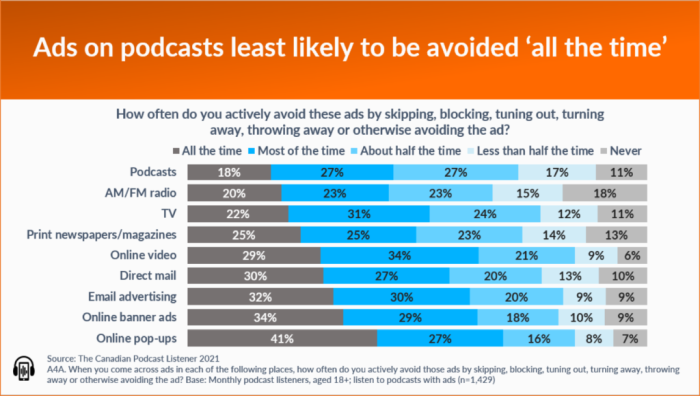 This guest column by Jeff Vidler, President and Founder of Signal Hill Insights Inc. in Ontario, was first published on the Signal Hill blog. Signal Hill Insights is an audio research consultancy. Jeff Vidler is a regular speaker at RAIN Summits, and is the co-producer of the Canadian Podcast Listener Report.
This guest column by Jeff Vidler, President and Founder of Signal Hill Insights Inc. in Ontario, was first published on the Signal Hill blog. Signal Hill Insights is an audio research consultancy. Jeff Vidler is a regular speaker at RAIN Summits, and is the co-producer of the Canadian Podcast Listener Report.
The neck-snapping growth of podcast ad revenues is good news for podcasters, but it also presents some fundamental challenges as we look ahead.
The U.S. ad spend on podcasting has nearly doubled every two years since 2015. From an estimated $69m in 2015 to more than $1b in 2021, the IAB/PwC’s U.S. Podcast Advertising Revenue Study sees total ad spending on podcasts exceeding $2b by 2023.
Podcast advertisers are catching up to the opportunity provided by the steady growth of podcast listening. And there’s still plenty of headroom. Comparing media consumption to share of ad spend, the WARC (Worldwide Advertising Research Center) and GWI (Global Web Index) recently identified podcasts as the most underdeveloped of all ad supported media.
As ad revenues grow, they are also shifting. More big brand advertisers are coming into the medium with awareness campaigns. The IAB/PwC reports that the share of podcast ad dollars going to brand awareness went from 38% in 2018 to 45% in 2020. Brands like State Farm, NBC/Universal’s Peacock Network and T-Mobile are now sitting side-by-side among the leading podcast advertisers with the smaller direct-to-consumer companies such as Hello Fresh and Manscaped who use promo codes to drive site visits and sales conversions.
It is this second group—the direct response advertisers—who, relying on host-read ads from podcast hosts who like and use their products, helped to fuel the special relationship between podcast listeners and the ads that help support their favourite podcasts.
Podcast listeners are receptive to the ads they currently hear on podcasts. In the Podcast Download Fall 2021 study we conducted in partnership with CUMULUS MEDIA, six-in-ten weekly podcast listeners agreed they wouldn’t mind a couple of extra ads so their favourite podcasts can continue. And they are less likely to avoid podcast ads than ads in other media. In The Canadian Podcast Listener studies we conduct with support from TPX Canada, fewer monthly podcast listeners say they avoid ads ‘all time’ than the ads they see elsewhere. This is especially true of other digital media.

At the core of this receptivity are host-read ads. Hosts are the lynchpin of the deep engagement listeners feel for their favourite podcasts. Their personal or implied endorsements carry a lot of weight.
They’re also a big part of why podcast ads have been so effective. While other ad formats can deliver strong results, our Brand Lift Studies consistently show that host-read ads perform at levels that justify a premium cost-per-thousand (CPM).
Unfortunately, host-read ads aren’t easy to scale, especially as podcast campaigns get bigger. Finding the podcasts that deliver the right fit and managing copy points and approvals across multiple podcasts add complexity and cost to the podcast buy.
As a result, host reads are becoming a smaller piece of the pie. The latest IAB/PwC report has the share of podcast ad revenue going to host-read ads dropping 10 points in just one year, from 66% in 2019 to 56% in 2020.
The need for scale is steering podcasts towards automated programmatic advertising. Programmatic advertising simplifies the buying process and opens the door to new revenue opportunities for podcasters. But, at least in the short run, programmatic campaigns still need human care and attention. Just last week, Ashley Carmen of Hot Pod News wrote about an ad for The Sex Lives of College Girls TV show landing in a kids’ podcast
What other ad formats could complement the host read, be effective for advertisers and still provide a positive listening experience?
That’s the creative challenge. As the podcast industry moves towards scalable ad solutions, it needs ads that can deliver the premium CPM of host reads without disrupting the unique relationship listeners have with the advertising that supports their favourite podcasts.
In fact, as more brand advertisers come into podcasting, the opportunity may lie with ad creative that goes beyond what they can get from a host read or its traveling companion, the ‘announcer read’ (ads read by a staff announcer). Host reads can be particularly effective at driving sales conversions at the bottom of the marketing funnel. The big brands however often set their advertising goals at the top of the funnel, to increase brand awareness or cultivate a brand image.
Other ways for brands to harness the marketing power of podcasts:
- Using the ability of audio to paint pictures
- Having brands tell their own stories, or
- Having customers share stories about the brands they like and use.
Examples include:
- Luxury brands such as Chanel and Estée Lauder experimenting with both short-form and branded marketing campaigns with no call-to-action
- NPR’s Brand Soundscapes, where brands can showcase their mission, brand values or product features
The key is to preserve the symbiotic relationship between podcast listeners and advertisers while testing new ad formats. Like a good host read, new ad types need to be seen as delivering value to the listening experience. Otherwise, like a cheap condo in an exclusive waterfront property, they will only bring down the property values.
.
